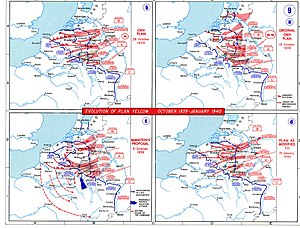Fall Gelb
| Manstein Plan/Fall Gelb (Case Yellow) | |
|---|---|
| Part of the Second World War | |
 Clockwise: Evolution of plans for German: Fall Gelb Case Yellow, the invasion of France and the Low Countries |
|
| Operational scope | Strategic |
| Location |
South-west Netherlands, central Belgium, northern France Coordinates: 50°51′00″N 04°21′00″E / 50.85000°N 4.35000°E |
| Planned | 1940 |
| Planned by | Erich von Manstein |
| Commanded by | Gerd von Rundstedt |
| Objective | Defeat of the Netherlands, Belgium and France |
| Date | 10 May 1940 |
| Executed by | Army Group A |
| Outcome | Victory |
The Manstein Plan was the primary war plan of the German Army during the Battle of France in 1940.
Developed by Generalleutnant (Lieutenant General) Erich von Manstein, the plan greatly modified the original 1939 versions of the invasion plan, Fall Gelb (Case Yellow) by Franz Halder, for the Battle of France. One way to look at the Manstein Plan was that it was the German response to the French Dyle Plan. Originally, in Aufmarschanweisung N°1, Fall Gelb (Campaign Instruction No 1, Case Yellow), the Germans planned to push the Allied forces back through central Belgium to the Somme river, in northern France, similar to the 1914 campaign of the First World War. On 10 January 1940, the Mechelen Incident occurred, when a German aircraft carrying documents containing parts of the operational plans of Fall Gelb crashed in Belgium, thus prompting another review of the invasion plan. While Fall Gelb was revised by Halder, not fundamentally changing it in Aufmarschanweisung N°3, Fall Gelb, Manstein was able to convince Hitler in a meeting on 17 February, that the Wehrmacht strategy should be an attack through the Ardennes, followed by an advance to the coast.
Manstein, chief of staff of Army Group A, had originally formulated his plan in October 1939 in Koblenz on instigation of his superior General Gerd von Rundstedt, who rejected Halder's plan, both because of professional jealousy and because it would not lead to a decisive victory over France. Manstein's first thoughts followed Vernichtungsgedanke, envisaging a swing from Sedan to the north, rapidly to annihilate the Allied armies in a Kesselschlacht (cauldron battle). When discussing his intentions with Lieutenant-General Heinz Guderian, commander of the XIX Panzer Corps, the latter proposed to turn it into a strategy following the thinking of J. F. C. Fuller, by avoiding the main body of the Allied armies and swiftly advancing with the armoured divisions to the English Channel, to cause the Allies to collapse by catching them off guard and cutting their supply lines. It was thus Guderian who introduced the true "Blitzkrieg" elements to the plan, while Manstein had at first many objections against this aspect, especially fearing the long open flank created by such an advance. Guderian managed to convince him that the danger of a French counterattack from the south could be averted by a simultaneous secondary spoiling offensive to the south, in the general direction of Reims. Guderian before the war had generated much interest for the theories of Fuller but never fully endorsed them.
...
Wikipedia
